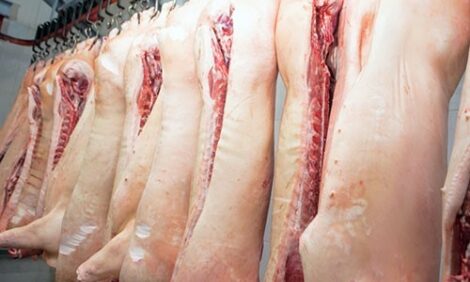



K-State’s Biosecurity Research Institute Hosts Symposium on ASF
US - Scientists from around the world visited Kansas State University’s Biosecurity Research Institute 15-17 May to take a global look at the highly contagious viral disease, African swine fever (ASF). The researchers assembled to give updates on research and in some cases, the status of ASF in their countries.ASF has not been found in the United States, but is a serious problem in
Africa and outbreaks have occurred in other countries, including Spain,
Italy, Russia, and the Dominican Republic. There is no vaccine or treatment.
Changes in production practices and increasing globalization have increased
the risk of introducing ASF into North America and other parts of the world,
according to the Center for Food Security and Public Health at Iowa State
University.
“ASF is spreading in many areas of the world which means that there is an
increasing threat of introduction into the United States,“ said Stephen
Higgs, research director of the BRI and symposium coordinator. “Something as
simple as a discarded sandwich containing meat from an infected pig could be
enough to cause an outbreak. Although we might be able to contain an
outbreak in commercial pigs, the consequences could be devastating to our
booming and highly competitive pork industry. Due to the growing numbers of
feral swine that are widely distributed in the US, the virus could then
become established here.“
Humans are not susceptible to the African swine fever virus (ASFV), but when
an outbreak occurs in any region or country, the financial and physical
implications can be devastating to the swine industry and those related to
it. During outbreaks in Malta and the Dominican Republic, for example, the
swine herds of the entire countries were completely depopulated.
The effect on a swine herd can vary depending on the strain, from near 100
per cent mortality to cases of low virulence isolates that can be difficult
to diagnose.
Species that can be infected include domesticated members of the pig family,
as well as wild species, such as wild boars, warthogs and bush pigs, the
latter species usually without clinical signs.
“We have 20 million feral pigs in Australia, so if African swine fever
arrives, we might have a problem we could never get rid of,“ said Martyn
Jeggo, director of the Australian Animal Health Laboratory. He said
Australia has a commercial swine herd of about 2.5 million head.
The disease can be transmitted by direct contact with infected animals,
ticks, or indirect contact with fomites – inanimate objects or substances,
such as clothing, furniture, or soap – that is capable of transmitting
infectious organisms from one individual to another. Other blood-sucking
insects such as mosquitoes and biting flies may also be able to mechanically
transmit the virus.
With the economic, physical and emotional toll of the foot-and-mouth disease
outbreak in the United Kingdom during 2001 still fresh, John Fazakerley,
director of the Institute of Animal Health in Pirbright, UK said, “The
country wants the capacity to deal with whatever comes along.“ Estimated
costs of the FMD outbreak ranged from $8 billion to $13 billion, and 6.5
million animals were slaughtered.
“The emergence of African swine fever virus (ASFV) in the Republic of
Georgia, followed by further spread throughout Russia establishes this
pathogen as a high threat pathogen for the US,“ said Juergen Richt,
director of the Department of Homeland Security Center of Excellence for
Emerging and Zoonotic Animal Diseases headquartered at Kansas State
University. For that reason, K-State, in collaboration with national and
international partners, is planning to conduct research on the virus.
“Our short term plans include adaptation and validation of the ASFV
challenge model developed by our colleagues at the Plum Island Animal
Disease Center,“ Mr Richt said. The model will establish a baseline for future
vaccine studies, Mr Richt said.
Richard Bishop, senior molecular biologist with the International Livestock
Research Institute in Nairobi, Kenya spoke of the importance of the swine
herd in Africa, adding that even one pig can make a significant difference
in a family’s income. He said that the pig population in Africa increased
284 per cent from 1980 to 1999 and that pork consumption during the period
almost doubled.
ASF is currently a problem in Russia, but scientists are facing challenges
in combating the disease.
“It’s difficult to explain to authorities that this is very important,“ said
Denis Kolbasov, director of the National Institute of Veterinary Virology
and Microbiology in Vladimir, Russia. “The cost of control is an
impediment,“ he said, adding that because Russia does not export pork, ASF
is not considered a trade issue.
Scientists from Spain, Kenya, Canada, Ukraine and several US states also
participated in the symposium.








